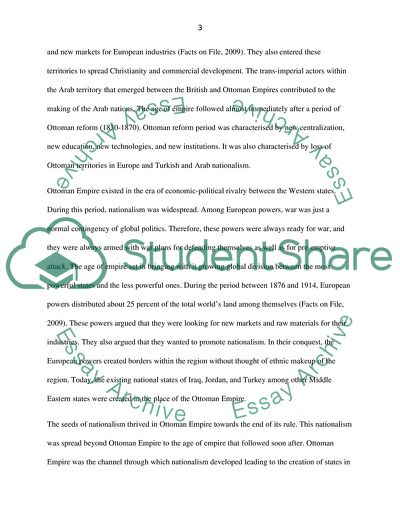Cite this document
(Nationalism in the Age of Empire and the Formation of Middle Eastern Nations Essay Example | Topics and Well Written Essays - 2000 words, n.d.)
Nationalism in the Age of Empire and the Formation of Middle Eastern Nations Essay Example | Topics and Well Written Essays - 2000 words. https://studentshare.org/history/1874370-to-what-extent-is-the-development-of-nationalism-in-the-age-of-empire-useful-to-understand-the-evolution-of-a-state-system-in-the-middle-east-in-the-interwar-period
Nationalism in the Age of Empire and the Formation of Middle Eastern Nations Essay Example | Topics and Well Written Essays - 2000 words. https://studentshare.org/history/1874370-to-what-extent-is-the-development-of-nationalism-in-the-age-of-empire-useful-to-understand-the-evolution-of-a-state-system-in-the-middle-east-in-the-interwar-period
(Nationalism in the Age of Empire and the Formation of Middle Eastern Nations Essay Example | Topics and Well Written Essays - 2000 Words)
Nationalism in the Age of Empire and the Formation of Middle Eastern Nations Essay Example | Topics and Well Written Essays - 2000 Words. https://studentshare.org/history/1874370-to-what-extent-is-the-development-of-nationalism-in-the-age-of-empire-useful-to-understand-the-evolution-of-a-state-system-in-the-middle-east-in-the-interwar-period.
Nationalism in the Age of Empire and the Formation of Middle Eastern Nations Essay Example | Topics and Well Written Essays - 2000 Words. https://studentshare.org/history/1874370-to-what-extent-is-the-development-of-nationalism-in-the-age-of-empire-useful-to-understand-the-evolution-of-a-state-system-in-the-middle-east-in-the-interwar-period.
“Nationalism in the Age of Empire and the Formation of Middle Eastern Nations Essay Example | Topics and Well Written Essays - 2000 Words”. https://studentshare.org/history/1874370-to-what-extent-is-the-development-of-nationalism-in-the-age-of-empire-useful-to-understand-the-evolution-of-a-state-system-in-the-middle-east-in-the-interwar-period.


